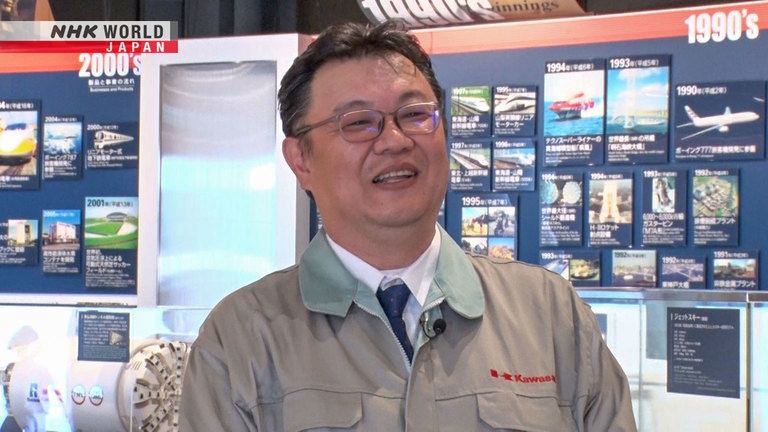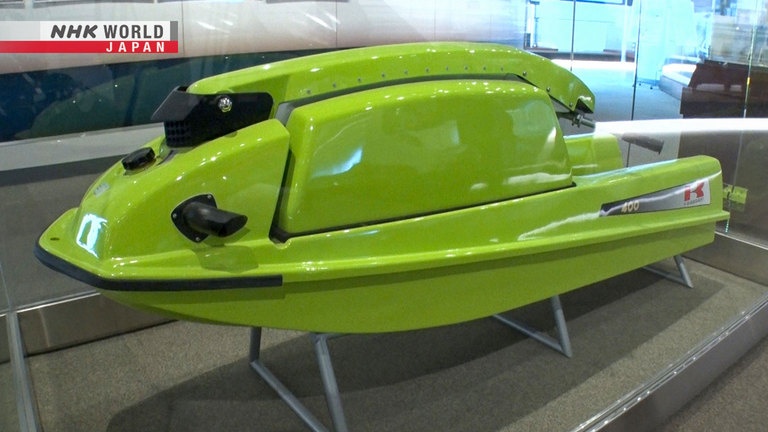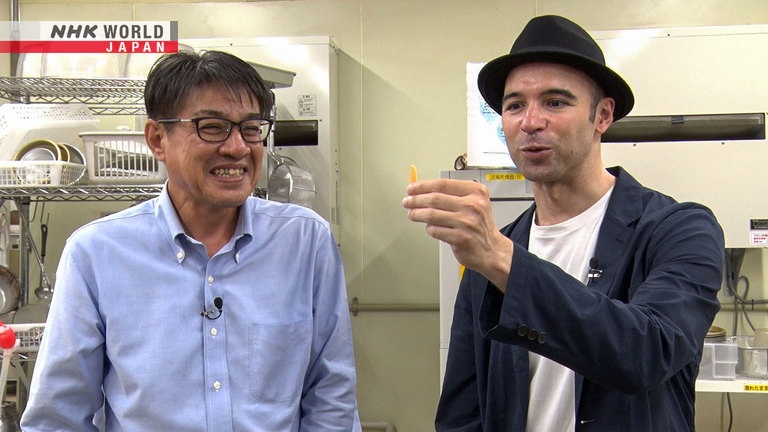Stand-Up Personal Watercrafts / Rice Crackers with Peanuts
The fascinating stories and secrets behind hit Japanese products, plus parts and machines that boast the top share of niche markets. In the first half: the story behind highly maneuverable stand-up personal watercrafts. In the second half: rice crackers with peanuts, an ever-popular snack in Japan.



Transcript
"Japan's Top Inventions"
The behind-the-scenes tales of hit products and creations from Japan.
This is "Japan's Top Inventions."
On today's show, stand-up personal watercrafts.
What's the story behind this invention which lets you race across the waters?
Later on the show, a Japanese snack factory.
What could this white dough be for?
Stay tuned to find out.
Hello. Welcome to "Japan's Top Inventions."
I'm your host, Jason Danielson.
In the first half of the show, we take you "Behind the Creation."
Today's topic is this.
Stand-up personal watercrafts.
A powerful jet pump ejects water out of the back of the vehicle,
propelling it forwards.
Fast models can go over 100 kilometers per hour,
delivering high-speed thrills on the water.
Over 50 countries are part of
an international personal watercraft sports association,
with races taking place around the world.
Development began some 50 years ago.
The display room of a motorcycle manufacturer in Kobe, west Japan.
Bikes from over the decades are shown off here.
But among them...
This is an early model.
A stand-up personal watercraft, from 1973.
The rider holds the handlebars while standing up.
An engine-powered jet pump propels the machine,
reaching speeds of up to 50 kilometers per hour.
You can really feel the speed on it.
This watercraft helped introduce the world to a new form of marine sports.
Our story begins back in the 1970s.
Motorcycles had become a popular form of transportation.
Japanese manufacturers were expanding into foreign markets
and fighting for market share.
A company in greater Kobe was one of them.
The company's focus was motorcycles,
but they wondered whether their engine tech could be used for other purposes.
This led to the development of a snowmobile engine.
"Now, what can we make next?"
The management explored their options.
They decided to turn their attention to marine recreation.
Japan's economy was booming,
and options for entertainment were increasing.
People were enjoying going out on motorboats and sailboats.
This is current personal watercraft developer, Kato Hironori.
Here's what he heard about those times.
It was a time when Japan's economy was hot,
so people were getting more receptive to having fun on the water.
It was an area where growth was expected,
so the company was looking to put out a new product in that space.
And so, a team was assembled to develop the new product.
The members came together to discuss where to start.
It was the company's first time working in marine recreation.
What kind of product would be best?
The team members researched what was out there.
A certain activity looked promising.
Waterskiing.
Participants are pulled along the surface of the water by a motorboat
while balancing on skis.
But in order to do it, someone needs to be driving the boat.
It's not a sport that you can do by yourself.
That became the core concept,
a vehicle which let you have an experience like waterskiing on your own.
Waterskiing requires a boat to tow the skier,
so it's not something that you can do by yourself.
The team decided to create a vehicle
which would give you a similar sensation to waterskiing,
but by yourself. That was the idea.
While the team continued to work out their ideas...
over in the US, in Los Angeles,
a man had come by the company's subsidiary in America.
He was a motocross enthusiast,
and he had an idea for a new product.
It was a concept that he had been thinking about for some time.
Motocross is an exciting, high-speed sport.
With the thrills however, comes the risk of getting hurt in a crash.
But what if you were racing on water instead?
A sketch revealed a vehicle that you stood on,
with handlebars like a motorcycle.
The man explained that this was like a motorcycle for the water.
It moved with a jet pump, not a propeller.
After the presentation, work began on a prototype.
This is a photo of the actual prototype from the time,
a "motorcycle for the water."
February 1972,
on the coast of Florida in the US.
The prototype was to be taken out for its first test drive.
We needed to actually drive it around,
test reliability, durability, areas of improvement
before we could move into mass production.
Test time.
The rider stepped aboard.
Water sprayed behind as the vehicle moved forwards.
The prototype picked up speed.
The rider tilted the handlebars...
and went into a smooth turn.
But then...
the rider lost his balance, and fell into the water.
This is a photo from the test.
The prototype was flipped over, bottom up.
The engine requires air for combustion.
There's an air intake.
When the prototype flipped over, the air intake went underwater,
and water started flowing inside.
More and more water gets in, and it damages the engine.
If all it took to break the vehicle was tipping over once,
it would never make it to market.
The team had run aground.
The prototype had a major flaw.
If the vehicle tipped over in the water,
there was a chance that the rider wouldn't be able to make it back to shore.
How could the team address this?
Inspiration would come from something unexpected.
Was it possible for the vehicle to flip itself back over?
First, the team tried making the handle portion
out of reinforced plastic instead of metal.
They wanted to make the vehicle as light as possible.
But what else could be done?
After much consideration,
it was decided that they would use the same principle as a certain something,
a roly-poly toy,
that rolls back up when pushed down.
There's not much to go off making something for the first time,
but they had the idea to borrow from roly-poly toys.
If the vehicle flipped over, it would roll back up, just like the toy.
A roly-poly toy has a weight at the bottom.
When the toy is knocked over, the weight rises up,
and gravity pulls it back down to where it was.
Similarly, the vehicle would have its center of gravity at the bottom.
That way, if it tipped over, gravity would help flip it back up.
The team made the body larger,
and inserted polystyrene foam to improve buoyancy.
The heavy engine would be placed at the bottom.
The team continued to adjust the center of gravity.
February 1973, two years after development started,
the stand-up personal watercraft was complete.
The company decided to target the US market first,
as marine sports were popular there.
But the product was completely new and unique.
When they test-marketed the product,
it turned out that people weren't very receptive.
It was brand new, so it would have looked unfamiliar to people.
I think it was important to actually show people what it looked like in action.
That was when the team decided to showcase their product
with a live demonstration so that people could see it
with their own eyes.
They looked for a resort area in the Caribbean Sea
and settled on the Bahamas, a popular destination for marine sports.
They brought something fresh off the assembly line in Japan.
I think excitement was very high for the new product,
but there was also a lot of uncertainty.
The watercraft was unloaded at the beach.
It was then floated into position on the water.
Local dealers and related parties had been invited to the event.
If the demonstration went poorly, word would spread quickly.
The team watched as the rider started the engine.
And it was off!
First, the watercraft moved in a straight line, picking up speed.
Water sprayed around as the vehicle accelerated.
Then came the turns.
The crowd watched and cheered.
There's a picture of the dealers all facing the same way.
It had grabbed their attention.
I think it would have made quite an impression to those
who were watching there that day.
But then, the rider lost his balance and the vehicle tipped over.
The developers held their breath.
The watercraft flipped right back up, just like a roly-poly toy.
The rider got back on and accelerated.
He boldly took a curve at high speed.
It was a beautiful maneuver!
The crowd burst into applause.
It was the first time that people outside the company had seen it in action.
I think people were excited by the possibilities
this new ride offered for marine recreation.
The team must have been very happy to hear the cheering.
And so, the demonstration was a resounding success.
Reputation began to grow across the US.
More and more people purchased one,
and a new genre of marine sport was born.
Afterwards, stand-up personal watercrafts became popular in the US
and all over the world.
How do experts view this invention?
We're joined by Tanabe Akira to learn more.
Welcome to the show.
Thanks for having me.
What do people like most about stand-up personal watercrafts,
in terms of water sports?
A stand-up model is not very stable on the water.
Especially when a person gets on it,
the center of gravity shifts up and it becomes unstable.
But if you're able to balance on it, it's a real thrill to ride one.
I think a large part of its popularity
comes from being able to master how to ride it.
I see. What uses do personal watercrafts have outside of leisure?
Most personal watercrafts these days are for two or three people to sit on.
In Japan, the coast guard, the police, and lifeguards
use them for patrolling and rescue efforts.
Those are some examples of organizations
which are making use of these vehicles.
During the recent Tokyo Olympics and Paralympics,
the police formed a personal watercraft unit for patrol and rescue.
That's another example of them being used.
It's been over 50 years since the debut of personal watercrafts.
What are some of the latest trends?
The bodies have gotten larger and more stable.
There are more options targeting usability
like audio systems, GPS, and cameras.
There are even models out there with fish finders
installed for going out fishing,
or ones with a cooler box in the back for the fish.
Many people around the world love personal watercrafts.
What do you think Japanese manufacturers bring to the table?
It's expected that markets in Asia, like China or India,
are going to grow significantly.
When a product reaches a new market,
it's important not only to sell but to educate the customers.
Both are important.
A personal watercraft is a kind of boat.
A rider is a captain.
And boats can be very dangerous.
They can cause serious injury or harm.
You have to have knowledge of the boat and of the surrounding environment.
It's the responsibility of Japanese manufacturers
to help raise awareness on how to keep safe.
Thanks for your time today. Good speaking with you.
Same here. Thank you.
Top Niche Creations.
Our next segment is "Top Niche Creations."
Today, we're looking at these.
Japanese rice crackers.
This is the snack aisle at a Japanese supermarket.
There are currently over 300 rice cracker manufacturers in Japan,
and lots of different varieties.
But there's one company that owns
about 70% of the domestic market share for a certain type of cracker.
Just what do they make? We sent our reporter to find out.
Hey everyone, this is Cyrus Nozomu Sethna.
Today I am in Niigata City.
The headquarters of the rice cracker manufacturer we're visiting
is right over here. Let's head on over.
The largest rice cracker manufacturer in Japan, located in Niigata City.
Hello.
Welcome.
Iida Koichi, who is in charge of development, is our guide today.
In here.
Whoa-ho-ho! Incredible!
We're first shown a variety of rice crackers that the company makes.
There are standard soy sauce flavored ones,
ones wrapped in seaweed,
ones with edamame bean, shaped like hexagons.
And what are these long white ones?
These are for infants.
They can start eating them at around seven months.
I have a little taste.
It's light.
It melted right in my mouth.
Rice crackers used to mainly be eaten by older people.
But we have the ability to make crackers of a variety of textures,
from softer to harder.
Wow, impressive.
Among all these crackers, which one has 70% of the market?
It's these rice crackers with peanuts.
The crackers have a distinctive crescent shape, and are mixed with peanuts.
It's soy sauce flavor with a tiny bit of heat.
Every once in a while, you'll want a bit of variety.
The peanuts offer a different texture, and there's a hint of sweetness.
So you eat the crackers, have a peanut, and have more crackers.
We wanted to create this cycle.
I see.
Lately, they've come out with another variety.
They seem slightly larger but... what's different?
These are made and sold in India.
It's been changed to suit local tastes.
They're bigger. Different flavor.
Just what do they taste like?
It does indeed smell different.
It's spicy.
It's chili and garlic flavor for the local market.
It's spicier than in Japan.
Also, they're a tiny bit crunchier.
But the crackers are not just international.
They even went to space three years ago.
They were brought onto the International Space Station.
It made the news that a Japanese astronaut ate them in space.
A rice cracker that's also space food.
Just how do they make it?
First, rice flour is steamed and made into dough.
It's shaped into bars.
On closer inspection,
you can see that the cross section is like a crescent.
Next is the cutting.
They're cut 1.6 millimeters thick.
Then, they're baked in an oven.
The result?
Fascinating. So the baking is what makes it expand.
You can tell from the final product.
That's right.
What's it like inside?
This is a CT scan of a baked cracker.
You can see the thin slice of dough is now hollow inside.
This is what gives it its signature crunch.
We want it to have a good crunch.
That's why we incorporate air into the dough,
so that when it's baked, it creates this hollow.
I see. There's a lot that goes into this.
Right.
The company owns 70% of the domestic market share
for these rice crackers with peanuts.
It was founded in 1946 in Niigata, which is famous for rice.
With the rice harvest becoming abundant in the 1950s,
they looked to use the rice to make crackers.
In 1966, the rice crackers with peanuts became a hit,
and they started developing other products.
Now they are the top rice cracker manufacturer in Japan,
with over 300 varieties.
The company is also leveraging their expertise
to branch out into other types of food manufacturing.
We were given a new product to try.
- You're making bread?
- That's right.
And how does it taste?
Nice and chewy.
Yes, it's different than regular bread.
Why has this top cracker manufacturer started making bread?
The answer? This ingredient here.
It's ground rice flour.
So, this is also rice.
We've long been making crackers.
Rice is gluten-free.
Our research has shown us that there are many rice product possibilities.
And you can use that expertise to make bread.
Rice still has a lot of untapped potential.
It's very exciting.
The company has been making rice crackers for over 70 years.
They've also been actively researching rice.
The company has discovered rice-derived microorganisms with health benefits.
This is what they look like.
They're a type of probiotic.
We commonly think of probiotics as derived from animal products, like yogurt.
However, these probiotics are derived from rice.
Just like the animal-derived ones,
these rice-derived probiotics are also thought to benefit intestinal health.
The company has developed supplements with them.
Who would have thought you could go from rice crackers to probiotics?
Wow!
That's all for this episode of "Japan's Top Inventions."
We'll leave you with more about the stand-up personal watercrafts
from the first half of the show.
See you next time! And stay inventive.
(Stand-up personal watercrafts have been around for over 50 years.)
(The latest models have double the top speed of the originals.)
(Enthusiasts worldwide compete using these watercrafts.)
(Kato Hironori helps manage the company's personal watercraft business.)
(He's here having a look at their early model.)
(It all started here.)
It represents the pioneering spirit to me, attempting something new.
If it wasn't for this model, we wouldn't have today's personal watercrafts.
Whenever we want to get back to basics, we refer to it.